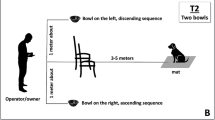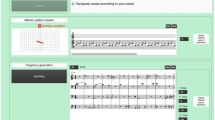Abstract
At present the capture and recognition of sounds from different animal species have great value in making biological and environmental research in certain areas affected by humans. In this paper, two topologies for five species of anurans are proposed using a database that contains samples of sounds emitted by them. For the development of systems is performed processing audio signals to digitize it; then, the samples to extract the main features that will be our input system for subsequent classification methods using back-propagation and self-organized maps are processed.


Similar content being viewed by others
References
Agostini M (2012) Myths and truths about toads and frogs. In: Frogs and toads background your home. Publishing house Universidad de La Plata (Edulp): Buenos Aires, Argentina, 37
AmphibiaWebEcuador. Introduction. Ecuador, Museum of Zoology. http://zoologia.puce.edu.ec/Vertebrados/Anfibios/AnfibiosEcuador/Default.aspx
Bardeli R, Wolff D, Kurth F, Koch M, Tauchert KH, Frommolt K-H (2010) Detecting bird sounds in a complex acoustic environment and application to bioacoustic monitoring. Pattern Recogn Lett 31(12): 1524–1534, 174, 175, 182
Castaneda-Delgado JE, Cervantes-Villagrana AR, Rivas-Santiago B (2012) Antimicrobial peptides: a likely arsenal against HIV infection. Invest clín 53(1):71–83
Chou C-H, Hsinchu Chung Hua Univ, Lee C-H, Ni H-W (2007) Bird species recognition by comparing the HMMs of the syllables. 5–7 Sept 2007
Chou C-H, Liu P-H, Cai B (2008) On the studies of syllable segmentation and improving MFCCs for automatic birdsong recognition. In: Proceedings of the 2008 IEEE Asia-Pacific Services Computing Conference. Washington, DC, USA: IEEE Computer Society
Cueva-Fernandez G et al (2015) Fuzzy system to adapt web voice interfaces dynamically in a vehicle sensor tracking application definition. Soft Comput. doi:10.1007/s00500-015-1709-2
DARPA Neural Networks studies (1988) AFCEAInternational Press, p 60
Data Mining Tools (2007) WEKA (Waikato Environment for Knowledge Analysis). Juan A. Botía Blaya. November 27, 2007
Díaz Luis M, Cádiz Antonio (2007) Descriptive guide for identifying calls announcement of cuban eleutherodactylus frogs (anura: leptodactylidae)
Inventory and Monitoring Techniques for amphibians of Tropical Andean region [online] pp 92, 2006. http://www.amphibians.org/wp-content/uploads/2013/07/Monitoreo-de-anfibios-baja-final.pdf
Kohonen T (2001) Self-organizing maps. Springer: ISBN: 978-3540679219
Laurila A, Kujasalo J (1999) Habitat duration, predation risk and phenotypic plasticity in common frog (Rana temporaria) tadpoles. J Anim Ecol 68:1123–1132. doi:10.1046/j.1365-2656.1999.00354.x
Lee C-H, Han C-C, Chuang C-C (2008) Automatic classification of bird species from their sounds using two-dimensional cepstral coefficients. IEEE Trans Audio Speech Lang Process 16(8):1541–1550, 173, 175, 177, 181, 182
López RF, Fernández JM (eds) (2013) Artificial neural networks: theoretical fundamentals and practical applications. Series, methodology and data analysis in social sciences. Netbiblo, pp 83-85
Marsh DM, Trenham PC (2008) Current trends in plant and animal population monitoring. Conserv Biol 22(3):647–655 173
Mcilraith AL, Card HC (1997) Birdsong recognition using backpropagation and multivariate statistics. IEEE Trans Signal Process 45(11):2740–2748
Mesa D, Bernal A (2005) Protocols for the preservation and management of biological collections. Sci Bull Mus Center Mus Nat Hist 10:117–148
Multivariate analysis (Diploma in Statistics). Item 3: Principal component analysis. http://halweb.uc3m.es/esp/Personal/personas/jmmarin/esp/AMult/AMult.html
Nicolás T, Giraldo TN Salazar JT (2006) Anuran species recognition by their songs, audio files, using techniques of digital signal processing. Universidad Nacional branch office Manizales, December 2006
Ntalampiras S, Potamitis I, Fakotakis N (2011) Probabilistic novelty detection for acoustic surveillance under real-world conditions. IEEE Trans Multimed 13(4):713–719 182
Riedmiller (1993) Proceedings of the IEEE International Conference on Neural Networks (ICNN), San Francisco, pp 586–591
Selin A, Turunen J, Tanttu JT (2007) Wavelets in recognition of bird sounds. EURASIP J Appl Signal Process 2007(1):141–141 182
Selouani SA et al (2005) Automatic birdsong recognition based on autoregressive time-delay neural networks. In: Proceedings of ICSC Congress Computational Intelligence Methods and Applications, pp 1–6
Semwal VB, Mondal K, Nandi GC (2015) Robust and accurate feature selection for humanoid push recovery and classification: deep learning approach. Neural Comput Appl 1–10. doi:10.1007/s00521-015-2089-3
Semwal VB, Raj M, Nandi GC (2015) Biometric gait identification based on a multilayer perceptron. Robot Auton Syst 65:65–75
Sin-Horng C, Wen-Yuan CC-JL (1996) A speech recognition method based on the sequential multi-layer perceptrons. Neural Netw 9(4):655–669
Veintimilla D, Salinas K, Aguirre N (2014) Anuros diversity patterns in the paramo ecosystem of the Podocarpus National Park. Cedamaz, vol 2, septiembre, pp 31–39
William R, González AMA (2014) Neural networks through shared maps in mobile devices. Int J Interact Multimed Artif Intel 3(1):28–35
You-Jia C, Heng-Ming C, Jui-Jiun J, Sheng-Chieh T, Yi-Ju Y, Chenn-Jung HP-AH (2014) Intelligent feature extraction and classification of anuran vocalizations. Appl Soft Comput 19:1–7
Zainuddin OPZ (2011) Modified wavelet neural network in function approximation and its application in prediction of time-series pollution data. Appl Soft Comput 11(8):4866–4874
Funding
This study was no funding.
Author information
Authors and Affiliations
Corresponding author
Ethics declarations
Conflict of interest
There is no conflict of interest.
Ethical approval
This article does not contain any studies with human participants or animals performed by any of the authors.
Additional information
Communicated by V. Loia.
Rights and permissions
About this article
Cite this article
Percy, S.F., Piedrahita, A.M., Escobar, R.F. et al. Comparison of neural network topologies for the classification of frogs by their songs. Soft Comput 21, 7099–7106 (2017). https://doi.org/10.1007/s00500-016-2252-5
Published:
Issue Date:
DOI: https://doi.org/10.1007/s00500-016-2252-5




